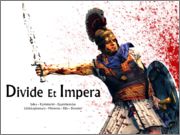Roman Light Artillery Quinquereme - Lithobolos (Ship)
A quinquereme is a 45 meter long galley with three decks of oars, in a pattern of 2-2-1 oarsmen, developed around 400 BCE by the Syracusans. Its large size allows many marines on board, and also allows ballistae to be mounted on the large decks.(Stone-Thrower)
Ballista bolt or falx? Does it matter how an enemy dies?
The 'five', called a quinquereme in Latin and a penteres in Greek, was a ship first used by the Syracusans against the Carthaginians sometime around 398BC. Like other polyremes, a term meaning many-oared, the chances were that it did not have five banks of oars but that the word 'oar' was used to mean 'rower'. In such a case, the arrangement of rowers would be two-two-one going up from the waterline. It makes sense to keep as much weight as possible low in the vessel to help its stability; a high centre of gravity makes any ship liable to capsize if struck from the side. The quinquereme, then, would be a formidable vessel both in terms of appearance and combat value. With a large fighting contingent aboard and plenty of deck space, this heavy vessel could cope with most enemies and threats.
(Lithobolos (Ship))
At close targets, a ballista could be aimed effectively but accuracy came at a cost in range; it could fire around 500 metres. The machine used two torsion springs with levers inserted into twisted ropes made from animal sinew, giving incredible power for its size. Firing either solid shot or bolts, it was equally effective against infantry or cavalry, but could also be deployed to destroy light fortifications during sieges. Originally developed by the Greeks around 400BC, and based on the oversized Oxybeles composite bow, ballistae were widely used by many cultures of the period, including the Romans. Later Roman versions included adjustable caps that enabled crews to quickly alter the tension of each sinew bundle to provide balance and therefore improve accuracy.
Unit Name Roman Light Artillery Quinquereme - Lithobolos (Ship) |
Main Unit Key Dac_Ballista_Five |
Land Unit Key Dac_Ballista_Shp |
Naval Unit Key barbarian_roman_ballista_five |
Soldiers 40 |
Category Medium Ship |
Class Artillery Ship |
Custom Battle Cost 960 |
Recruitment Cost 960 |
Upkeep Cost 192 |
Ship Health 817 |
└ Ship barbarian_roman_five_art |
Ship Speed 3 |
Missile Damage 89 |
├ Engine ballista_medium_ship |
├ Missile Weapon rome_ballista_shp |
├ Projectile shp_stone_flammable |
├ Missile Damage 49 |
├ Missile Ap Damage 40 |
└ Base Reload Time 27 |
Accuracy 40 |
Range 435 |
Reload 4 |
Shots Per Minute 2 |
Ammunition 1 |
Melee Attack 9 |
Weapon Damage 5 |
├ Melee Weapon rome_shortsword |
├ Weapon Damage 5 |
├ Weapon Deadliness 0 |
├ Armour Piercing No |
├ Bonus vs. Cavalry 0 |
├ Bonus vs. Elephants 0 |
└ Bonus vs Infantry 0 |
Charge Bonus 6 |
Melee Defence 30 |
├ Base Defence 14 |
├ Shield none |
└ Shield Defence 16 |
Armour 10 |
├ Armour cloth |
├ Armour Defence 10 |
└ Shield Armour 0 |
Health 25 |
├ Man Entity rome_infantry_medium |
├ Man Health 20 |
└ Bonus Hit Points 5 |
Base Morale 40 |
Abilities
Roman Light Artillery Quinquereme- Row Hard 20
Increases speed for 20 strokes.
Ship speed
- Stamina (average)
Governs how fast the unit tires and restores fatigue, and is dependent on type of unit, weight and approach to combat.
Attributes
No Attribute
Strengths & Weaknesses
Roman Light Artillery Quinquereme- Average hull strength
- Skeleton crew
- Average speed
- Average ramming
- Abysmal boarding
- Exceptional missile combat
- Very accurate
- Very long range
- Fast rate of fire
- Lower damage than other artillery
- Easily destroyed
| Faction Availability | |
|---|---|
| Grand Campaign | |
| Imperator Augustus | |


 Français
Français Italiano
Italiano Deutsch
Deutsch Español
Español Русский
Русский Čeština
Čeština Polski
Polski Türkçe
Türkçe 简体中文
简体中文 正體中文
正體中文 日本語
日本語
